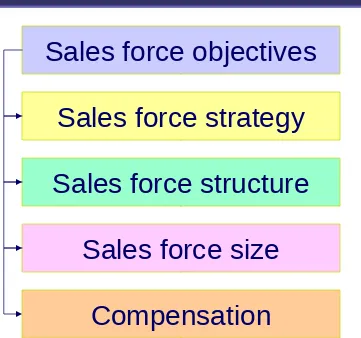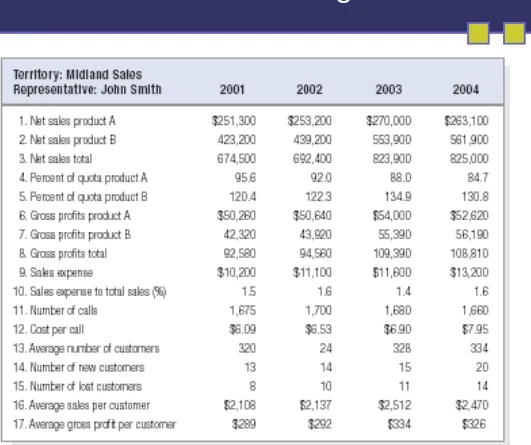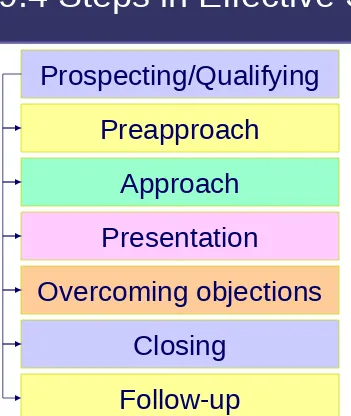MARKETING MANAGEMENT
12th edition
19
Managing Personal
Communications
19-2
Chapter Questions
• How can companies use integrated direct marketing for competitive advantage?
• How can companies do effective e-marketing?
• What decisions do companies face in designing a sales force?
• How do companies manage a sales force efficiently?
• How can salespeople improve selling,
19-3
Direct Marketing
Use of consumer-direct channels to reach and deliver goods and services to
19-4
Direct Marketing Channels
Catalogs
Direct mail
Telemarketing
Web sites
Email marketing
Mobile devices
19-5
Public Issues in Direct Marketing
Irritation
Irritation
Unfairness
Unfairness
Deception/fraud
Deception/fraud
19-6
Constructing a Direct-Mail Campaign
Establish objectives Select target prospects Develop offer elements
Test elements Execute
19-7
RFM Formula for Selecting
Prospects
Recency Recency
Frequency Frequency
19-8
Elements of the Offer Strategy
• Product • Offer
• Medium
19-9
Components of the Mailing
• Outside envelope
• Sales letter
• Circular
• Reply form
19-10
Types of Telemarketing
• Telesales
• Telecoverage
• Teleprospecting
• Customer service
and technical
19-11
Other Media for Direct Response
Television
• Direct Response Advertising
• At-home shopping channels
19-12
Designing an Attractive Web Site
19-13
Ease of Use and Attractiveness
• Ease of Use
– Downloads quickly
– First page is easy to understand
– Easy to navigate
• Attractiveness
– Clean looking
– Not overly crammed with content
– Readable fonts
19-14
Increasing Visits and Site
Stickiness
• Deep information with links
• Changing news of interest
• Changing offers • Contests and
sweepstakes
19-15
Online Ads
• Banner ads • Microsites
• Sponsorships • Interstitials
• Search-related ads • Content-targeted
advertising • Alliances
19-16
19-17
e-Marketing Guidelines
• Give the customer a reason to respond
• Personalize the content of your emails
• Offer something the customer could not get
via direct mail
19-18
Figure 19.2 Designing a Sales Force
Sales force objectives Sales force strategy Sales force structure
19-19
Types of Sales Representatives
• Deliverer
• Order taker
• Missionary
• Technician
19-20
Sales Tasks
• Prospecting • Targeting
• Communicating • Selling
• Servicing
19-21
Figure 19.3 Managing the Sales Force
Recruiting, selecting Training
19-22
Workload Approach to
Determining Sales Force Size
• Customers are grouped into size classes
• Desirable call frequencies are established
• Number of accounts in each size class
multiplied by call frequency
• Average number of calls possible per year
established
19-23
Components of Sales Force Compensation
Fixed amount
Variable amount
Expense allowances
19-24
What Motivates Sales Reps?
Most Rewarding
• Pay
• Promotion
• Personal growth • Sense of
19-25
19-26
Figure 19.4 Steps in Effective Selling
Prospecting/Qualifying Preapproach
Approach Presentation
Overcoming objections Closing
19-27
Marketing Debate
Are Great Salespeople Born or Made?
Take a position:
1. The key to developing an effective sales force is selection.
19-28
Marketing Discussion
Pick a company and go to the Web
site. How would you evaluate
the Web site? How well does it
score on the 7 C’s design



